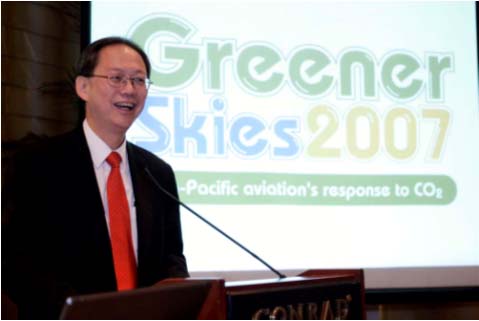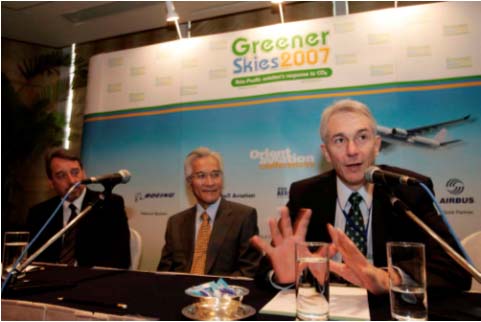Copyright © 2024 Swire Pacific Limited. All rights reserved.
Cathay Pacific Airways Chief Executive Philip Chen announced today that the airline is developing a carbon offset scheme that will allow the airline to "neutralise" a percentage of its carbon emissions by investing in projects in the Pearl River Delta that will help improve the environment.
Under the proposed scheme, being developed as part of Cathay Pacific's overall environment management strategy, the airline will establish a mechanism to offset emissions associated with Cathay Pacific staff travelling on official airline business and also provide passengers with the entirely voluntary option of joining the offset programme.
Carbon-offset schemes are increasingly common in Europe and the United States, but are still in their infancy in Asia. Cathay Pacific is taking the lead as part of a programme of initiatives to improve efficiency, reduce fuel burn and contribute to environmental improvement.
Mr Chen announced the development during a keynote speech delivered at the "Greener Skies Forum 2007", being held in Hong Kong on 29-30 March to enable Asia Pacific aviation to develop an industry-wide response to the issue of carbon emissions and climate change. Cathay Pacific is the Official Airline for the forum, which has brought together key players from the region's airlines and aviation bodies.
"Cathay Pacific has seen a 20% improvement in fuel efficiency since 1998," said Mr Chen. "In addition to our internal measures to upgrade the fleet, control fuel uplift and reduce aircraft weight, we also work with industry partners to support route and air-traffic management improvements. We are now developing this programme for carbon offsetting as part of our overall environmental strategy and our commitment to the Hong Kong Clean Air Charter."
In his address, Mr Chen said the impact of carbon emissions on climate change is being brought into sharper focus, "but I can honestly say that we are a responsible industry that has done a lot of good work to minimise any adverse impact on the environment. Aviation makes a substantial contribution to social and economic progress, with an estimated 8% contribution to global gross domestic product. And, while aviation is increasingly being viewed as one of the biggest contributors of carbon emissions, that is simply not the case. The contribution the industry makes to man-made carbon dioxide emissions worldwide is estimated at 2%."
Mr Chen said the industry needs to continue the drive towards improved technology, including research into alternative fuels, while infrastructure changes are needed to address the fuel wastage created by inadequate route and air-traffic management. He added that an open system for emissions trading would help to help drive overall emissions reduction, and that the International Civil Aviation Organization (ICAO) must take the lead in this regard.
FACTS - Aviation and the Environment
Cathay Pacific's Initiatives
IATA member airlines support a four-point strategy to address climate change


Cathay Pacific Airways Chief Operating Officer Tony Tyler makes a point during the Airline Chiefs Panel Discussion at the Greener Skies Forum. Also pictured are Director-General of the Association of Asia-Pacific Airlines Andrew Herdman (left) and Singapore Airlines Chief Executive Officer Chew Choon Seng (centre).
The Cathay Pacific website can be found at www.cathaypacific.com